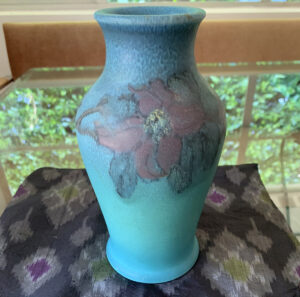 ES owns a eight-and-a-half-inch tall matt blue vase accented with a purple peony design with the “flame” mark for Rookwood pottery. The date stamp reads 1926. ES, your little vase represents a worldwide rise of a new style of ceramics, Art Pottery. This international art movement began in the late 19th century, evolving till the mid-20th century.
ES owns a eight-and-a-half-inch tall matt blue vase accented with a purple peony design with the “flame” mark for Rookwood pottery. The date stamp reads 1926. ES, your little vase represents a worldwide rise of a new style of ceramics, Art Pottery. This international art movement began in the late 19th century, evolving till the mid-20th century.
Female artists and creatives became instrumental in the craze for ceramics of this era. One great example is the founder of Rookwood Pottery in Cincinnati, Maria Longworth Nicols (1849-1932). As an amateur she painted on unfired white porcelain, a genteel hobby in her day for wealthy females at home. For a half of a century she lead her pottery company to international success. Rookwood won the International Gold Medal at the world’s fair, the Exposition Universelle in Paris in 1889. The firm closed its doors in 1967. David Rago’s book American Art Pottery: The Golden Age 1880-1920 states, “No single company achieved so much for so long as Rookwood, which put artwork above commercial considerations.”
Art Pottery and the Arts and Crafts Movement
Art Pottery serves as a concrete example of the philosophy of the Arts and Crafts Movement. Its roots come from England in the writings of the polymath John Ruskin and the Pre Raphaelite artists in the second quarter of the 19th century. They espoused a return to handmade crafts, and simple Gothic traditions in architecture and design, opposed to industrialization and machine made objects. The philosophy emphasized the dignity of labor and purity of art. Art pottery claimed to be handmade or decorated by hand. Although also a factory, Rookwood stressed the human element in every pot created.
The diversity in the functions of tableware required in the dining rooms of the late 19th century to 1920s led to unique forms in ceramics. Consider a centerpiece bowl with a flower frog. The technological advancements of the era led to unique glazes, innovative colors, and female-inspired designs. Interior decoration became not only the realm of the female, but females became the leading consumers of fine ceramics.
ES’s vase bears the monogram for Rookwood artist Margaret Helen McDonald (1913-1948). Over half of Rookwood’s craftspeople were women, as were most of founder Nichols’ management team.
A Truly International Movement
Art Pottery from all over the world sat on the stages of the hundreds of World’s fairs held throughout the globe. At the 1876 Centennial Exhibition in Philadelphia, Japanese, Chinese, Italian, French, Middle Eastern pots showed alongside American pots. Rookwood, for example hired Japanese potter Kataro Shirayamadani who moved to Cincinnati.
Art pottery borrowed design elements from many cultural traditions as well as objects created in the Arts and Crafts style, Art Nouveau, and Art Deco. ES’s vase gives an Art Deco feel, in a later date for Art Pottery. Notice the purple peonies underneath the mat glaze, yet on top of the blue of the vase.
The potter starts with an unfired vessel called greenware, painted with an underglaze slip (clay) and a colorant. Then the mixture of slip and color is dried and ground, and reconstituted in water, and used as a paint color in lighter and darker hues to create a background. Each color the potter intends to use as part of the design is mixed, dried, and reconstituted. Design is layered on, then the almost finished vase, called biscuit, goes to its first kiln firing. Then it’s glazed, and fired again. The final firing fuses the overglaze to the surface of the clay.
Rookwood’s Legacy
Rookwood became known for innovations of glazes, colors, and especially for their most popular “Standard” style of glazing and designs. You might have seen the brown and tan glazed vases by Rookwood with portraits of late 19th century Native Americans. Or florals and insects, with an earth toned background combined with a warm colored painted decoration under a brilliant glaze, most popular from 1883-1909.
The bottom of ES’s vase bears the signature Rookwood flame incised mark, XXVI (the date 1926), and the model shape number as well as an “E,” a SIZE letter. A is the largest size in that shape, F is the smallest.
Rookwood’s founder Maria Longworth Nicols had interest in all the arts. She was the first female founder of an arts festival: The Cincinnati May Festival. Her second marriage was to a diplomat in Europe. She died in Paris, and her progeny are British and French nobility.